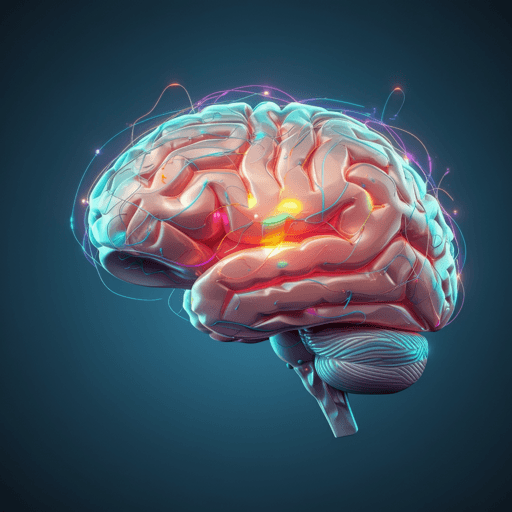
Psychology
Neural dynamics of spontaneous memory recall and future thinking in the continuous flow of thoughts
H. Su, X. Li, et al.
Research by Haowen Su, Xian Li, Savannah Born, Christopher J. Honey, Janice Chen, and Hongmi Lee reveals how spontaneous streams of thought—captured with a think-aloud fMRI paradigm—are shaped by the brain’s default and control networks. Thought boundaries resembling external event edges evoke similar activations, and specific connectivity patterns predict greater versus reduced variability in memory and future thinking.
~3 min • Beginner • English
Introduction
The study investigates how spontaneous thought—comprising episodic recollection, semantic memory, and future-oriented simulation—unfolds and transitions in natural settings without external task constraints. Prior work shows that during continuous recall, memory order and transitions reflect semantic and temporal associations and that transitions between distinct memories evoke characteristic neural responses, akin to segmentation of external experiences into events. However, most evidence stems from recall of controlled, experiment-induced content (e.g., lists, movies), leaving open the mechanisms that organize naturally occurring memory and future thinking. The authors adopt the spontaneous thought framework: thoughts arise freely without deliberate control or salient external stimuli, are often personally relevant, and share neural correlates with memory/future thinking in default and frontoparietal control networks. The central research questions are: (1) What organizing principles guide transitions from one spontaneous thought to the next? (2) What are the neural signatures of thought transitions (especially strong boundaries)? (3) How do interactions among brain networks generate variable versus stable thought trajectories? Using think-aloud during resting fMRI and detailed annotation into discrete thought units by topic and category, the authors test hypotheses about semantic association versus shared neurocognitive states in transitions, characterize boundary-locked neural responses, and relate functional connectivity to the global semantic structure of thought streams.
Literature Review
Extensive literature links spontaneous thought/mind-wandering with default network engagement and coupling with control networks, implicating self-generated cognition, episodic retrieval, future simulation, and self-referential processing. Event segmentation research demonstrates neural responses at stimulus-driven boundaries (e.g., hippocampus and posterior medial network), while recent work suggests internally generated context boundaries elicit stereotyped activation patterns in PMC and adjacent control network regions. Traditional methods (retrospective reports, experience sampling) limit tracking of uninterrupted thought flow; think-aloud provides continuous, fine-grained reports and reveals clustered trajectories with semantic stability and discrete boundaries, which relate to mental states and individual differences. Models of episodic/semantic memory emphasize semantic associations as organizing principles that cue related thoughts; Markov approaches capture transition dynamics across internal states. The default network’s medial temporal subsystem (including hippocampus and PHC) is proposed to generate variability via associative cueing and pattern completion, whereas the core default network constrains thoughts toward salient internal information, and the frontoparietal control network sustains goal-relevant content—suggesting distinct roles for these networks in thought variability versus stability.
Methodology
Participants: 126 recruited (18–40 years, mean age ~23.7; 76 female, 50 male), right-handed native English speakers with normal hearing/vision. Exclusions: 8 from all analyses (audio quality, technical interruptions, instruction non-adherence). Additional 43 excluded from fMRI (excess motion n=39; structural anomalies n=2; projector issue n=1; unidentified artifact n=1). Final: 118 for behavioral analyses (73 females, mean age 23.4), 75 for fMRI analyses (43 females, mean age 23.4).
Procedure: Single 10-min think-aloud session in MRI. Instructions: continuously verbalize thoughts (past memories, future plans, sensations, perceptions); let thoughts flow freely; avoid entertaining the experimenter or over-explaining; permitted to withhold private content by naming topic only. Visual display: “Begin” cue (2 s) then fixation cross. Speech recorded via MR-compatible microphone; participants trained to minimize head motion.
Behavioral preprocessing: Audio transcribed (manual or Whisper Large-v2, then corrected). Transcripts segmented into sentences with timestamps. Fifteen independent annotators labeled each sentence with a thought category (0–6; fillers, current, episodic, semantic-self, semantic-world, future, other) and a short topic label. Sentences with mixed content were split into clauses. Consecutive sentences with same category and topic were merged into thought units. Quality checks for labeling consistency and errors.
MRI acquisition: 3T Philips Ingenia Elition, 32-channel head coil. EPI: TR=1.5 s, TE=30 ms, flip 52°, multiband=4, 60 oblique axial slices, 112×112 grid, 2×2×2 mm³ voxels. Fieldmap acquired. T1 MPRAGE: 1×1×1 mm³.
MRI preprocessing: BIDS organization. FreeSurfer recon-all (v7.2.0) for anatomy and surfaces. fMRIprep (v21.0.2): motion correction, B0 unwarping, coregistration, resampling to fsaverage6 surface and MNI152 volume. Smoothing (FWHM=4 mm) with FreeSurfer (surface) and FSL SUSAN (volume). Nuisance regression (linear/quadratic trends, 6 motion params, global, CSF, white matter signals). No bandpass filtering. First 10 volumes discarded; motion outlier volumes (FD ≥1 mm) and ±2 volumes excluded. Time series z-scored per vertex/voxel.
Parcellation and ROIs: Schaefer 400-parcel atlas (17-network). ROIs: bilateral PMC (posterior cingulate cortex + precuneus parcels in Default Network A), bilateral auditory cortex (Somatomotor Network B), bilateral hippocampus (FreeSurfer Aseg in MNI volume). Network subregions for functional connectivity: Control Network B (IPL, PFCd, PFCld, PFClv, PFCmp, temporal lobe), Default Network A (IPL, PFCd, PFCm, temporal lobe, PMC), Default Network C (IPL, PHC, Rsp) + hippocampus.
Analyses:
- Univariate activation by category: For each parcel/ROI, mean BOLD within thought units (shifted by 4.5 s for HRF). Group contrasts: each internal category (semantic-world, semantic-self, episodic, future) vs current (paired t-tests; Bonferroni across 400 parcels). ROI ANOVAs for PMC/hippocampus; control for duration, word count, speech rate via regression.
- Category transition probabilities: Sentence-level Markov chain; 6×6 matrix per participant; paired t-tests versus chance (overall next-category proportion).
- Semantic similarity: SentenceTransformers all-mpnet-base-v2 embeddings (768-d). Cosine similarity across lags −15 to +15 per category; near (±1) vs far (±15) paired t-tests. Boundary-type comparisons: category-only vs topic-only vs both.
- Thought boundary agreement: Independent coders (N=185; 19 excluded for quality) segmented transcripts into thoughts; boundary agreement defined as proportion of coders marking a boundary at each moment; repeated-measures ANOVA across boundary types.
- Boundary-locked univariate: Strong boundaries (agreement=1) vs non-boundary (middle of long thoughts ≥15 s), 6-s windows shifted 4.5 s; parcel-wise paired t-tests (Bonferroni). PMC/hippocampus time courses aligned to boundary types; paired t-tests per time point with correction.
- Boundary pattern similarity: Correlate think-aloud strong boundary/non-boundary patterns with a between-movie boundary template (from prior dataset, processed per original pipeline). Parcel-wise one-sample/paired t-tests (Bonferroni); ROI analyses in PMC and auditory cortex. Silence control: correlate with movie-derived silent-period template.
- HMM event segmentation: BrainIAK eventseg; number of events matched participant strong boundaries (excluding excluded TRs). Overlap defined within ±1 TR (3-TR window) around strong boundary (shifted 4.5 s). Randomization test (1000 iterations) for significance.
- PMC pattern similarity across consecutive thoughts: Thought-wise PMC patterns (excluding 6 s post-offset; HRF shift 4.5 s); Pearson correlations between consecutive thoughts; Spearman correlation with boundary agreement; group one-sample t-test.
- Thought network structure: Semantic network per participant (nodes=thoughts; edges=cosine similarity; negative weights removed). Average clustering coefficient (NetworkX).
- Functional connectivity: Mean time courses per subregion; Pearson correlations within/between subregions. Within-network FC: averages within network; between-network FC: averages across subregion pairs. Correlate FC measures with clustering coefficients (theory-driven tests without multiple-comparisons correction). Post hoc subregion-pair analyses with Bonferroni.
Key Findings
Behavioral/content: Participants generated on average 54.5 thoughts (SD=19.9; range 19–118) and 1368.3 words (SD=376.2; range 368–2268). Internally oriented thoughts (memory/future) dominated (M=86.8%, SD=13.6). Category proportions: semantic-world M=28.1% (SD=12.4), future M=24.8% (SD=19.6), semantic-self M=18.6% (SD=11.0), episodic M=15.3% (SD=11.2), current state M=11.8% (SD=13.3), other M=1.4% (SD=4.1). Differences across categories were significant (F(5,585)=55.57, p<0.001, ηρ²=0.32). Mean duration differed across categories (F(4,344)=8.05, p<0.001, ηρ²=0.09). Current states comprised 57.6% of first thoughts.
Univariate activation by category: Default network (medial and lateral parietal cortex) showed higher activation for internal categories vs current; strongest for episodic and future. Temporo-parietal junction (salience/ventral attention overlap) was more activated during current state. PMC ROI: activation varied by category (F(4,224)=22.72, p<0.001, ηp²=0.29); internal categories (except semantic-self) > current (ts>2.02, ps<0.048, ds>0.37); episodic and future > semantic categories (ts>4.07, ps<0.001, ds>0.65); future > episodic (t(70)=3.73, p<0.001, d=0.61, 95% CI=[0.04, 0.12]). Hippocampus ROI: activation varied (F(4,224)=5.28, p=0.002, ηp²=0.09); all internal categories > current (ts>2.70, ps<0.009, ds>0.50); no significant differences among internal categories (ts<1.91, ps>0.060, ds<0.32).
Transitions and semantic organization: Category self-transitions exceeded chance in all categories except Other (ts>12.78, ps<0.001, ds>1.23). Semantic similarity was higher for consecutive thoughts (lags ±1) than distant thoughts (lags ±15) across categories (ts>9.98, ps<0.001, ds>1.22), with stronger near-similarity for internal categories than current (ts>4.41, ps<0.001, ds>0.57). Boundary agreement differed by transition type (F(2,230)=501.48, p<0.001, ηp²=0.81): both topic+category change > category-only (t(115)=28.67, p<0.001, d=3.00, 95% CI=[0.39, 0.45]), topic-only > category-only (t(116)=24.06, p<0.001, d=2.27, 95% CI=[0.32, 0.38]). Semantic similarity across boundaries was lower for both and topic-only vs category-only (t(115)=15.29, p<0.001, d=1.74, 95% CI=[0.09, 0.12]; t(116)=5.57, p<0.001, d=0.61, 95% CI=[0.03, 0.05]). Boundary agreement negatively correlated with semantic similarity (mean Spearman ρ=−0.33, SD=0.16; t(116)=−21.62, p<0.001, d=2.00).
Boundary-locked neural responses: Strong boundaries (agreement=1; pre/post semantic similarity M=0.19, SD=0.08) elicited greater activation in medial frontal/parietal default and control areas; non-boundaries showed greater activation in lateral frontal speech and auditory cortices. PMC showed elevated responses from 4.5–10.5 s post-boundary vs non-boundary (ts>4.21, ps<0.001, ds>0.66), scaling with boundary strength (topic-only weaker; category-only weakest). Hippocampus showed a modest, non-significant increase at 4.5 s (t(74)=1.97, p=0.052, d=0.37).
Distributed pattern similarity: Strong thought boundary patterns positively correlated with between-movie boundary patterns in parcels in/around PMC; correlations were greater than for non-boundary patterns. PMC ROI: positive correlation (t(74)=2.22, p=0.029, d=0.26) and stronger than non-boundary (t(74)=2.29, p=0.025, d=0.41). Silence controls indicated auditory cortex boundary pattern reflected absence of sound (boundary vs silence: t(74)=4.85, p<0.001; non-boundary vs silence: t(74)=−3.17, p=0.002), whereas PMC boundary pattern was not explained by silence (t(74)=0.73, p=0.465).
HMM segmentation and representational shifts: HMM-derived boundaries significantly overlapped with human-identified strong boundaries in default network parcels including PMC (PMC overlap M=11.8%, SD=12.8%; one-tailed randomization p<0.001). PMC pattern similarity between consecutive thoughts was negatively correlated with boundary agreement (mean Spearman ρ=−0.19, SD=0.26; t(74)=−6.37, p<0.001, d=0.74), indicating larger representational shifts across stronger boundaries.
Thought network structure and connectivity: Thought network clustering coefficients across participants: M=0.18, SD=0.05. Between-network FC between Control Network B and Default Network A positively correlated with clustering (r(73)=0.24, p=0.041, 95% CI=[0.01, 0.44]); Control B–Default C trend positive but not significant (r(73)=0.13, p=0.256). Within-network FC in Default Network C negatively correlated with clustering (r(73)=−0.29, p=0.013, 95% CI=[−0.48, −0.06]); Default A–Default C not significant (r(73)=−0.04, p=0.729). Post hoc subregion analyses: positive correlations between PMC (Default A) and lateral dorsal/ventral and medial posterior PFC (Control B) (r>0.23, ps<0.041); Control B temporal lobe–Default C retrosplenial cortex (r(73)=0.25, p=0.029). Within Default C, PHC connectivity with hippocampus, retrosplenial cortex, and IPL negatively correlated with clustering (r(73)<−0.23, ps<0.044), strongest for PHC–hippocampus (r(73)=−0.42, p<0.001; Bonferroni-corrected).
Discussion
The findings show that spontaneous thought transitions are primarily governed by semantic associations, with consecutive thoughts remaining semantically related and category states exhibiting temporal clustering. When prominent semantic shifts occur, they create internal boundaries that recruit midline default and adjacent control network regions, generating distributed activation patterns comparable to stimulus-driven event boundaries. Boundary responses in PMC likely reflect generalized signals of mental context transitions and internal task switching to resolve competition among upcoming thoughts, though this interpretation requires caution (reverse inference). Despite robust cortical boundary signals, hippocampal boundary responses were weak/non-significant, possibly due to sustained hippocampal engagement in continuous memory retrieval and thought generation throughout think-aloud, masking transient boundary effects. Beyond transient responses, strong boundaries aligned with HMM-detected pattern shifts and reduced PMC pattern similarity across consecutive thoughts, consistent with reconfiguration of higher-order representations at event/thought transitions. At the network level, stronger coupling between control and core default subsystems was associated with more stable, clustered thought structures, whereas stronger within-DN medial temporal subsystem connectivity (including hippocampus–PHC) was linked to greater variability/divergence—supporting a dynamic interaction whereby DNMTL promotes associative variability and FPCN–DNcore constrains thoughts toward goals and personally significant information. These results generalize event segmentation principles to internally generated narratives, highlighting how default and control networks jointly organize the dynamics of memory and future thinking in naturalistic streams.
Conclusion
This study bridges spontaneous thought and memory research by demonstrating that semantic associations and neurocognitive states organize the stream of internally generated thoughts. Strong thought boundaries evoke default/control network responses and boundary-specific activation patterns similar to those at external event boundaries, and HMM-based segmentation captures representational shifts across these boundaries. Functional connectivity within and between large-scale networks predicts individual differences in thought structure, with DNMTL coupling linked to variability and FPCN–DNcore coupling linked to stability. These insights aid interpretation of resting-state neural activity and suggest avenues for assessing psychological conditions and designing interventions. Future work should further disentangle category vs semantic dimensions, examine metacognitive and speech-generation influences on thought dynamics, leverage automated annotation to enhance consistency and scalability, and test generalization to real-world settings beyond the MRI think-aloud context.
Limitations
The think-aloud paradigm, while providing continuous access to thought flow, may constrain naturalistic content due to the MRI setting, awareness of being recorded, and potential social influences (self-censorship, over-explanation). Verbalization itself may alter spontaneous thought trajectories, making the cognitive/neural processes similar but not identical to task-free rest or real-world mind-wandering. Annotation relied on single annotators per transcript and subjective judgments, introducing potential human error and inconsistency; automated approaches may improve scalability and consistency. Additionally, boundary-related silence could confound auditory cortex responses (controlled in analyses), and the presence of other tasks in the scanning session could introduce context effects, though analyses focused on the think-aloud run.
Related Publications
Explore these studies to deepen your understanding of the subject.







